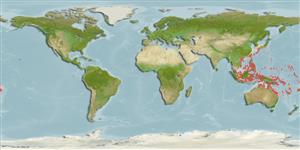Common names from other countries
Environment: milieu / climate zone / depth range / distribution range
Οικολογία
. Tropical
Western Pacific.
Length at first maturity / Μέγεθος / Βάρος / Age
Maturity: Lm ? range ? - ? cm Max length : 2.5 cm SHH αρσενικό/απροσδιόριστο; (Ref. 821)
Found in intertidal on gravel (Ref. 75835). Subtidal among rocks (Ref. 799).
Life cycle and mating behavior
Γεννητική Ωρίμανση | Αναπαραγωγή | Γεννοβολία | Αβγά | Γονιμότητα | Προνύμφες
Members of the order Archaeogastropoda are mostly gonochoric and broadcast spawners. Life cycle: Embryos develop into planktonic trocophore larvae and later into juvenile veligers before becoming fully grown adults.
Springsteen, F.J. and F.M. Leobrera. 1986. (Ref. 821)
IUCN Red List Status (Ref. 130435)
CITES status (Ref. 108899)
Not Evaluated
Not Evaluated
Human uses
| FishSource |
Εργαλεία
Περισσότερες πληροφορίες
Age/SizeΑύξησηLength-weightLength-lengthΜορφολογίαΠρονύμφεςΑφθονία
Διαδικτυακές πηγές
Estimates based on models
Preferred temperature
(Ref.
115969): 24.9 - 29.4, mean 28.4 (based on 1294 cells).
Vulnerability
Low vulnerability (10 of 100).
